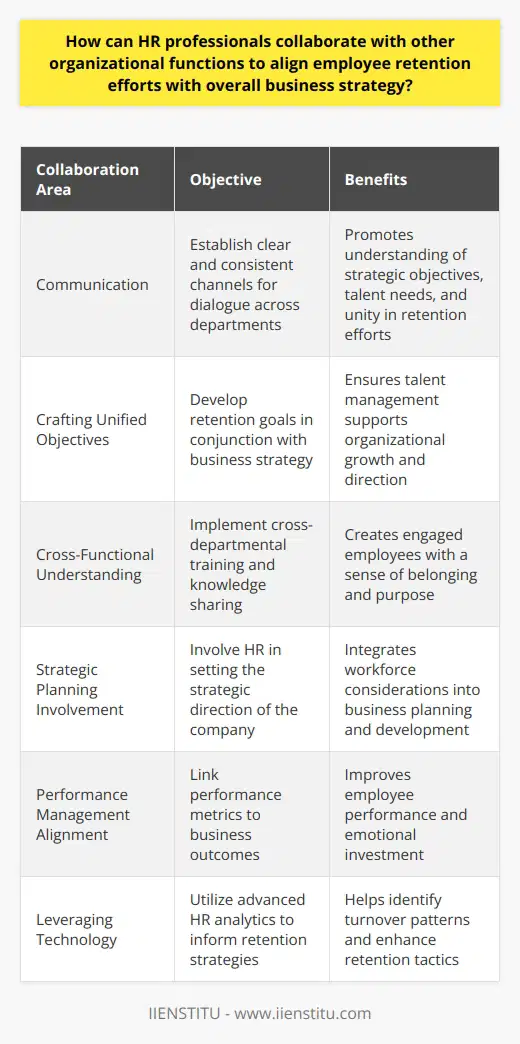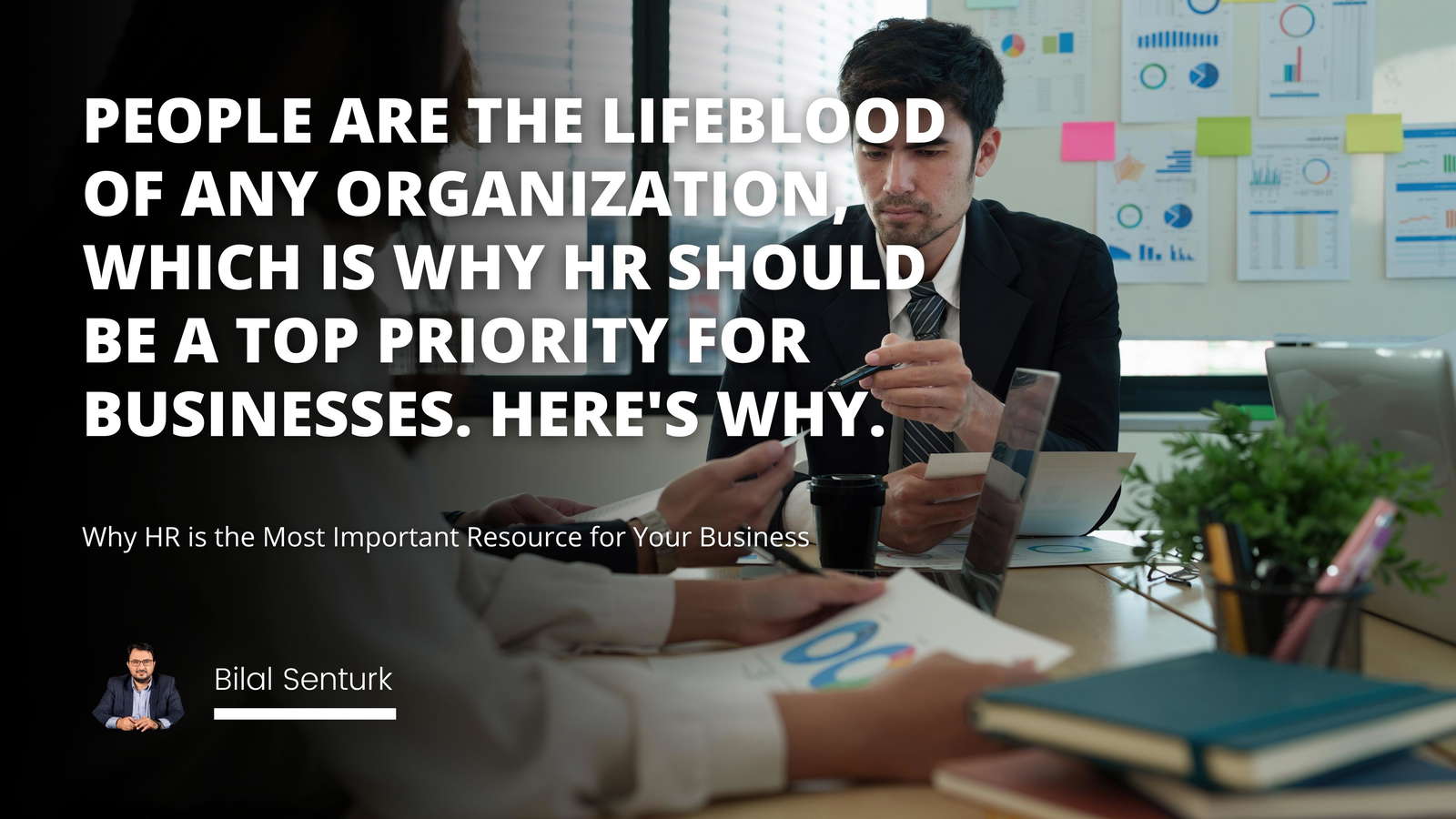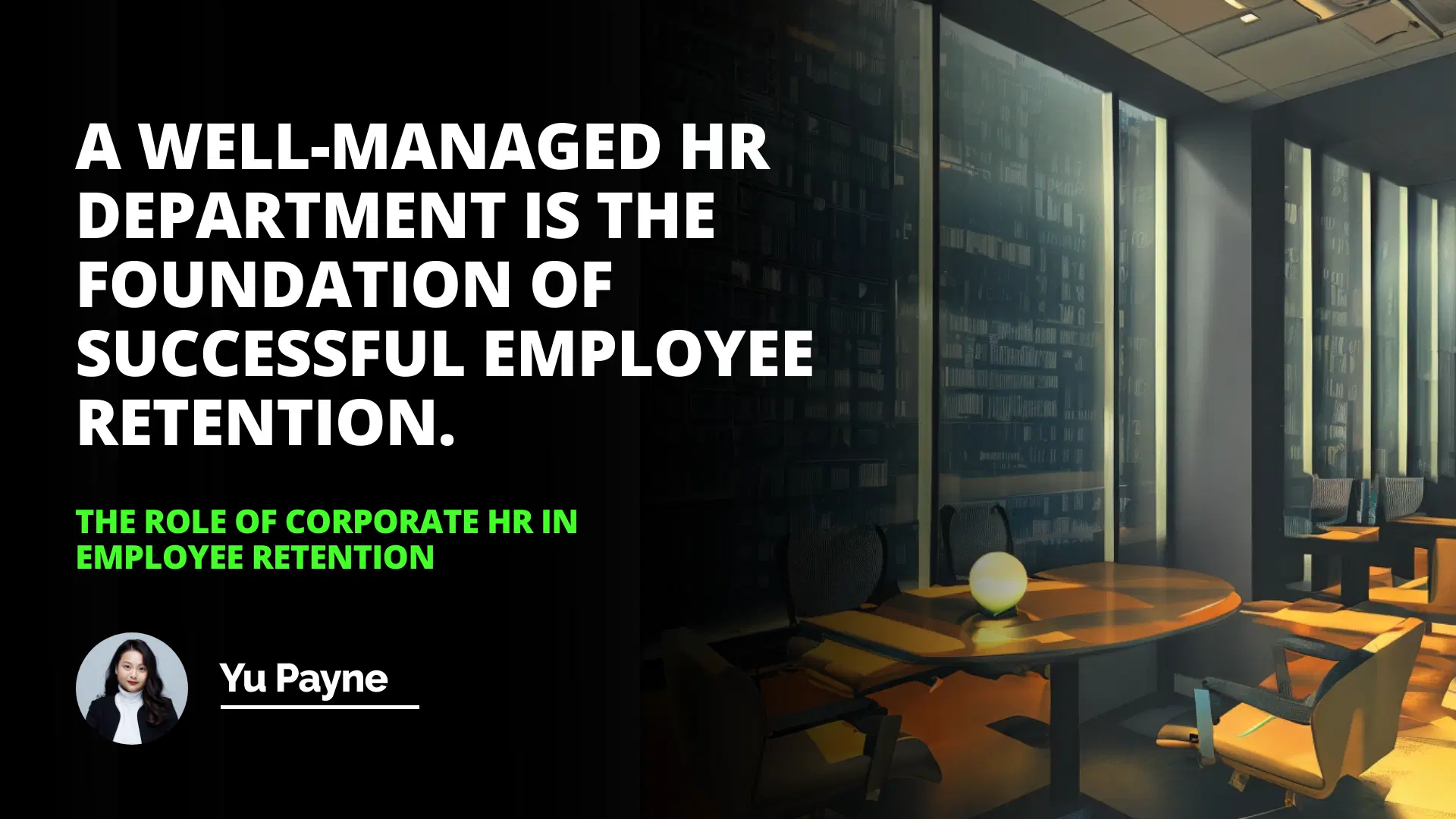
The success of any organization depends on the quality of its employees, making employee retention an essential factor in its success. Corporate HR has a significant role in employee retention and must formulate different plans and policies to create an environment where employees are motivated to stay.
These plans and policies should include a competitive compensation package, an excellent organizational culture, management practices, growth opportunities, and learning opportunities.
Introduction
The Need for Employee Retention
The Role of Corporate HR in Retaining Employees
Types of Plans and Policies Formulated by Corporate HR
Conclusion
Introduction: Employee retention is an important factor in the success of any organization. It is essential to ensure that the right kind of talent is retained in the organization to help it grow and handle any challenge in the changing business environment.
Corporate HR has a significant role to play in the retention of employees. By formulating different plans and policies, HR can create an environment where employees are motivated to stay with the organization.
The Need for Employee Retention
The success of any organization depends on the quality of its employees. Retaining the right kind of employees is essential to ensure that the organization has the right talent and skills to handle any challenge in the changing business environment.
It is also essential to ensure that the right attitude and behavior is retained in the organization, as this can significantly impact the organization's performance.
The Role of Corporate HR in Retaining Employees
The role of Corporate HR in the retention of employees is critical. HR has to ensure that the right policies and plans are formulated to create an environment where employees are motivated to stay with the organization.
This includes providing a competitive compensation package, an excellent organizational culture and management practices, growth opportunities, and learning opportunities.
Types of Plans and Policies Formulated by Corporate HR
Corporate HR has to formulate different plans and policies to ensure employee retention. These plans and policies should be tailored to the specific needs of the organization and the type of industry. Some of the plans and policies that HR can formulate include:
Good compensation package: A competitive compensation package is essential to ensure that employees are motivated to stay with the organization. This should include salaries, bonuses, and other benefits.
Good organizational culture and management practices: An excellent culture and management practices are essential to ensure that employees are motivated to stay with the organization. This includes providing a supportive and collaborative environment, flexible working hours, and rewards and recognition programs.
Good growth opportunities: It is crucial to provide employees with the opportunity to grow and develop within the organization. This can be done by providing training and development programs, mentoring opportunities, and career progression opportunities.
Good learning opportunities: It is essential to provide employees with the opportunity to learn new skills and knowledge. This can be done by providing seminars, workshops, and other learning opportunities.
Conclusion: Employee retention is essential for any organization to ensure it has the right talent and skills to handle any challenge in the changing business environment. Corporate HR has a significant role to play in the retention of employees.
By formulating different plans and policies, HR can create an environment where employees are motivated to stay with the organization. These plans and policies should be tailored to the specific needs of the organization and the type of industry.
A well-managed HR department is the foundation of successful employee retention.

Frequently Asked Questions
What strategies can Corporate HR use to improve employee retention?
Retaining talented employees is essential for a business to remain competitive. Corporate HR departments need to employ strategies that help to improve employee retention to ensure that their organization can attract and retain the best talent. There are several key strategies that Corporate HR can use to improve employee retention.
First, Corporate HR should ensure that employees are well-compensated and provided with a competitive package of benefits. An attractive compensation and benefits package can help motivate and retain employees. Additionally, Corporate HR should ensure that employees receive regular pay increases, bonuses, and other incentives. This will help employees feel valued and motivated to stay with the organization.
Second, Corporate HR should focus on creating a positive work environment. Employees should feel supported and appreciated in the workplace. Corporate HR should ensure opportunities for professional development and growth, as this will help keep employees engaged and motivated. Additionally, Corporate HR should strive to create a culture of respect and collaboration within the organization.
Third, Corporate HR should strive to provide employees with a sense of purpose and meaning in their work. Employees should feel that their work is meaningful and that their contributions are appreciated. Corporate HR should ensure that employees are given opportunities to work on meaningful projects and tasks and that their contributions are recognized.
Finally, Corporate HR should ensure that employees are given the resources and support they need to succeed in their roles. This could include providing training, resources, and mentorship. Corporate HR should ensure that employees are given the tools and support they need to do their best work.
In conclusion, Corporate HR can employ a variety of strategies to help improve employee retention. By providing employees with competitive compensation packages and benefits, creating a positive work environment, providing employees with a sense of purpose, and giving them the tools and support they need to succeed, Corporate HR can help to retain the best talent.
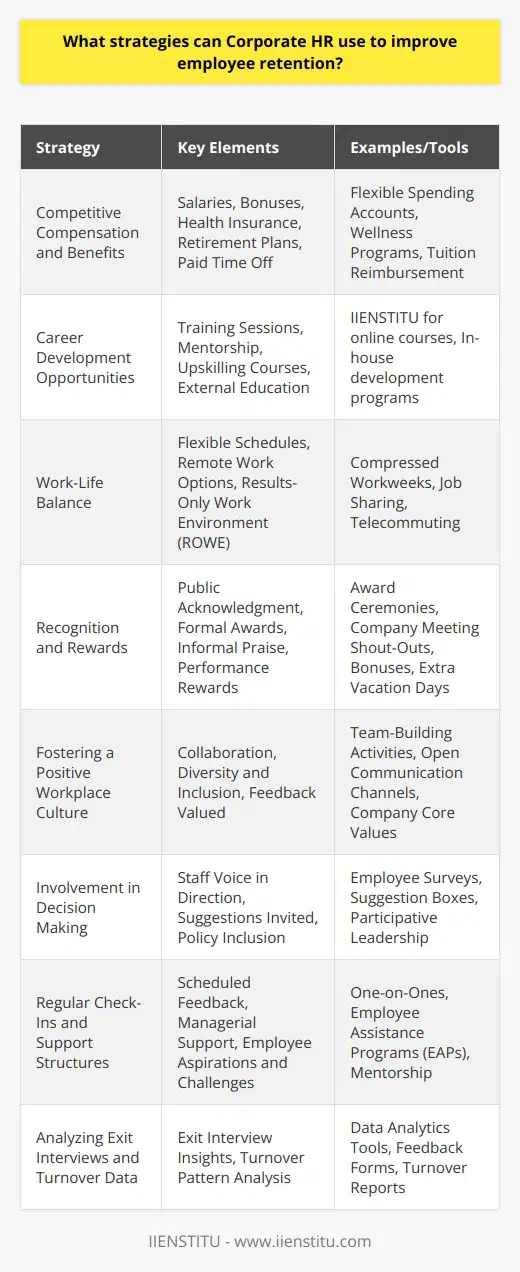
How does Corporate HR ensure that employee retention plans are effective?
Retention of employees is essential for any business as it ensures that the organization can continue to benefit from the knowledge and experience of key personnel. Corporate Human Resources (HR) plays a vital role in ensuring that employee retention plans effectively retain employees and promote a positive work environment.
One of the key strategies that corporate HR can use to ensure that employee retention plans are effective is to create a comprehensive retention plan. This plan should include strategies to attract, hire, and retain the right employees and methods to recognize and reward employee performance. Additionally, the plan should consider methods to ensure employees are engaged and motivated to stay with the company.
The second strategy that corporate HR should use to ensure effective employee retention plans are to create a culture of recognition and appreciation. This can be done by regularly recognizing employees' contributions and celebrating their successes. Corporate HR can also provide incentives such as bonus pay or additional vacation time for employees who demonstrate a long-term commitment to the organization.
The third strategy that corporate HR should use to ensure that employee retention plans are effective is to provide employees with opportunities for career development and growth. This can be done by offering employees the opportunity to attend professional development programs or seminars. Additionally, corporate HR can provide access to resources such as mentoring and coaching programs to help employees advance their careers.,
Finally, corporate HR should ensure that employee retention plans are adequately communicated to all employees. This can be done by sending out regular updates and reminders about the company’s retention plans.
Additionally, corporate HR should provide clear information about the benefits and opportunities that the company can offer to retain employees.
Corporate HR plays a vital role in ensuring effective employee retention plans. By creating a comprehensive retention plan, creating a culture of recognition and appreciation, providing employees with opportunities for career development and growth, and communicating the plan to all employees, corporate HR can ensure that employee retention plans are successful in retaining employees.
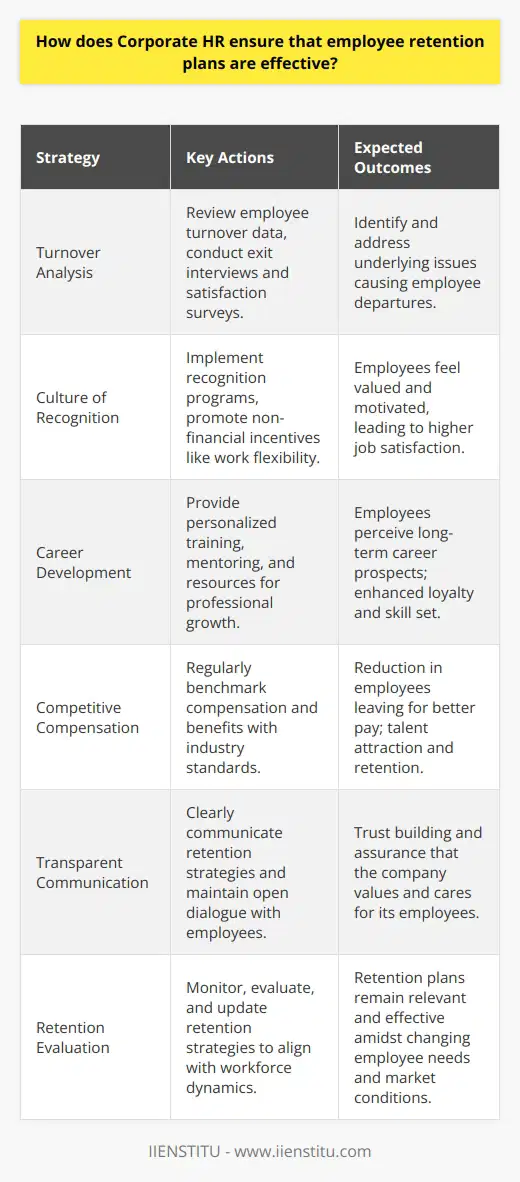
What are the benefits of Corporate HR's involvement in employee retention?
Employee retention is an important goal for any organization. Corporate HR’s involvement in employee retention can benefit the organization and its employees.
Studies have shown that actively engaging in employee retention can improve employee engagement and job satisfaction. Corporate HR can play an essential role in helping to ensure that employees feel valued and appreciated. This can include providing meaningful feedback, helping to match employees with roles they are best suited for, and offering incentives to encourage employees to stay.
In addition, corporate HR’s involvement in employee retention can help to reduce turnover and save the organization money. When employees feel supported and appreciated, they are more likely to stay with the organization for longer. This, in turn, can lead to greater organizational stability and fewer costs associated with onboarding and training new employees.
Furthermore, corporate HR’s involvement in employee retention can help create a continuous learning and development culture. By providing employees with opportunities to learn new skills and gain new knowledge, corporate HR can help ensure that employees continuously develop their skills and abilities. This can lead to improved performance and greater job satisfaction.
Finally, corporate HR’s involvement in employee retention can help ensure employees remain loyal to the organization. When employees feel that their contributions are valued and appreciated, they are more likely to stay with the organization for longer. This can lead to improved morale, greater job satisfaction, and improved organizational performance.
In summary, corporate HR’s involvement in employee retention can benefit the organization and its employees. It can lead to improved employee engagement and job satisfaction, reduced turnover and cost savings, a continuous learning and development culture, and increased employee loyalty. For these reasons, organizations must prioritize employee retention and actively engage their corporate HR teams.

What is the role of HR in fostering a positive work environment to enhance employee retention?
Role of HR in Creating a Positive Work Environment
Fostering Engagement and Collaboration
The role of HR in fostering a positive work environment is multifaceted, and one of the most significant roles is promoting employee engagement and collaboration. By implementing policies and practices that encourage open communication and teamwork, HR professionals can help create a supportive and inclusive atmosphere where employees are motivated to contribute their best efforts. This can not only increase job satisfaction but also build a sense of loyalty, further enhancing employee retention.
Providing Opportunities for Growth
Another essential function of HR in improving the work environment is offering employees opportunities for personal and professional growth. This can include providing training and development programs, promoting internal mobility, and creating clear career advancement paths. By showing an investment in employees' skills and potential, HR can help employees feel valued and appreciated, contributing to a positive workplace culture and reducing the likelihood of turnover.
Addressing Employee Wellbeing
Employee wellbeing is crucial for both individual success and overall organizational health. HR professionals are responsible for providing a safe and healthy workplace, and this includes addressing physical, mental, and emotional wellbeing. By implementing wellness initiatives, providing comprehensive benefits, and creating a culture of work-life balance, HR can contribute to a supportive work environment that enhances employee retention.
Recognizing and Rewarding Success
The role of HR in fostering a positive work environment also involves recognizing and rewarding employee accomplishments. By developing a fair and transparent rewards system and celebrating employees' successes, HR can help instill a sense of pride and motivation in employees. This acknowledgement and appreciation can contribute to a positive work culture and increase employee commitment.
Managing Conflict and Promoting Inclusivity
Finally, HR professionals have a responsibility to manage workplace conflicts effectively and actively promote an inclusive, diverse work environment. This can involve addressing workplace disputes, implementing policies to prevent discrimination, and fostering a culture of respect and inclusion. By taking serious steps to create an equitable workplace, HR can enhance employee satisfaction and improve retention rates.
In conclusion, the role of HR in fostering a positive work environment to enhance employee retention involves multiple aspects, including engaging employees, providing growth opportunities, addressing wellbeing, rewarding success, and promoting inclusivity. By focusing on these areas, HR professionals can create a supportive and motivating workplace that attracts and retains top talent.
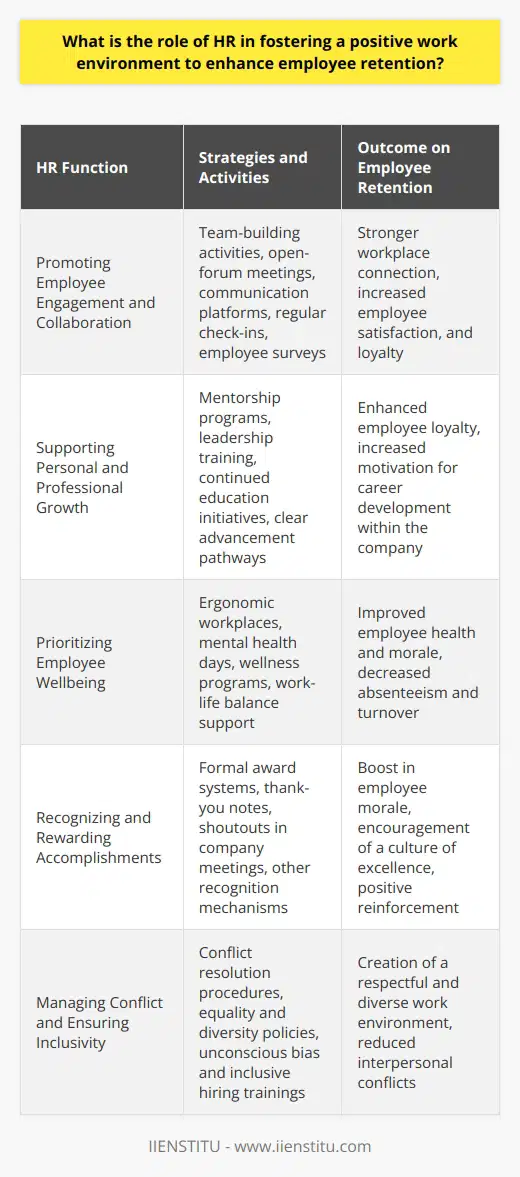
How does HR theory inform strategies for reducing employee turnover in organizations?
Role of HR Theory in Turnover Reduction Strategies
Underlying Principles
Human Resource (HR) theory provides a conceptual framework that guides organizations in the design and implementation of strategies aimed at reducing employee turnover. The foundation of HR theory is the belief that people are valuable resources, and investing in their development results in a competitive advantage.
Employee Engagement
HR theory emphasizes creating an engaging work environment that fosters employee commitment and satisfaction. Promoting open communication, offering meaningful work, and providing opportunities for growth are essential factors in retaining employees. Encouraging a healthy work-life balance and recognizing employees' achievements further enhance engagement.
Job Design and Recruitment
Tailor-made job designs based on HR theory directly impact employee retention. Establishing clear job expectations, providing appropriate training, and aligning tasks with individual skills and motivation ensure a match between employees and their jobs. Equally important is the recruitment process, where selecting individuals whose values and goals are compatible with the organization's culture reduces turnover rates.
Performance Management
A solid performance management system, grounded in HR theories, plays a vital role in identifying and addressing issues that might lead to turnover. Setting performance objectives, providing regular feedback, and continuously developing employees' skills not only promote personal growth but also enhance their perception of organizational support.
Compensation and Benefits
Competitive compensation packages and benefits, designed with HR theory in mind, contribute directly to employee loyalty. Including performance-based rewards, offering non-financial benefits such as flexible working hours, and providing comprehensive healthcare packages signal the organization's commitment to employees and their well-being.
Organizational Culture
A supportive organizational culture that adheres to HR principles helps to establish a sense of belonging and loyalty among employees. Embracing diversity and inclusion, maintaining transparent communication, and promoting teamwork and collaboration contribute to a nurturing environment that discourages employee turnover.
In conclusion, when organizations seek to reduce employee turnover, adopting strategies informed by HR theory is essential. These strategies, including employee engagement, job design, performance management, compensation, and organizational culture, help create an environment that supports employees and encourages their long-term commitment.

How can HR effectively identify and address the root causes of high employee turnover?
Root Cause Analysis
To effectively identify and address the root causes of high employee turnover, HR professionals must first conduct a comprehensive root cause analysis. This analysis entails collecting and examining employee data from various sources, including exit interviews, employee satisfaction surveys, and performance evaluations.
Employee Retention Metrics
Next, HR should establish key employee retention metrics that can be regularly monitored and evaluated. These metrics may include factors such as employee engagement, job satisfaction, and performance levels. By consistently tracking these indicators, HR can identify early warning signs of potential turnover problems.
Work Environment
One common reason for high employee turnover is a poor work environment. HR can address this issue by collaborating with managers to create a more positive and inclusive workplace culture. This may include developing and implementing initiatives such as diversity and inclusion programs, team-building activities, and recognition systems.
Job Satisfaction
Another essential factor in reducing high employee turnover is job satisfaction. HR should assess whether employees find their jobs fulfilling and develop strategies to improve satisfaction. This could involve conducting regular performance reviews, offering career development programs, and implementing a fair and transparent reward system.
Managerial Effectiveness
Effective management also plays a significant role in employee retention. HR can work with managers to improve their leadership and communication skills, as well as provide training on effective techniques for supporting, motivating, and retaining employees. Additionally, HR should promote the importance of conducting regular check-ins and providing constructive feedback.
Work-Life Balance
Maintaining a healthy work-life balance is an integral aspect of employee retention. HR can support this by advocating flexible working hours, remote work options, and stress reduction initiatives. These measures can help employees achieve a better balance between their professional and personal lives, ultimately leading to decreased turnover rates.
Conclusion
In conclusion, to effectively identify and address the root causes of high employee turnover, HR professionals should adopt a systematic approach that involves analyzing employee data, monitoring key retention metrics, and implementing targeted strategies. By addressing issues like work environment, job satisfaction, managerial effectiveness, and work-life balance, HR can significantly reduce turnover rates and improve overall employee satisfaction and retention.
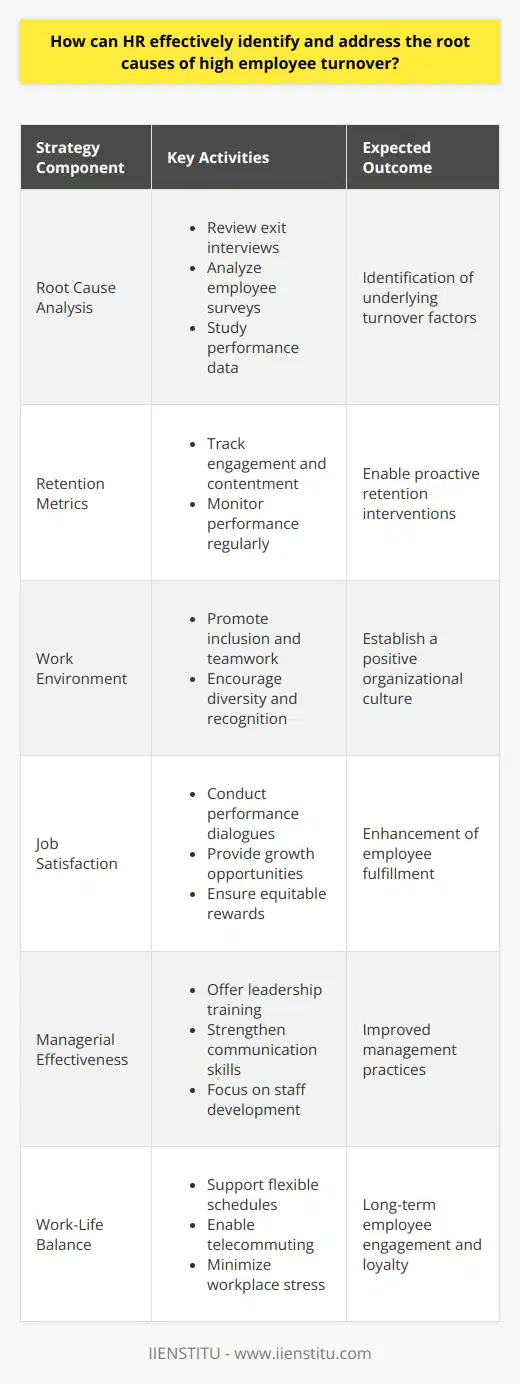
How can HR contribute to the development of a company culture that promotes employee retention?
**Role of HR in Company Culture Development**
Human Resource (HR) departments play a vital role in developing a company culture that fosters employee retention. Through strategic planning and implementation, HR contributes to creating an authentic and cohesive company culture that values employee development and satisfaction.
**Effective Recruitment and Onboarding**
One way HR supports employee retention is by ensuring effective recruitment and onboarding processes. Hiring the right candidates who fit the company culture contributes to their long-term commitment, as they feel a sense of belonging and alignment with the organization's values. Additionally, smooth onboarding sets the stage for new employees to understand expectations and integrate with the company's culture.
**Learning and Development Opportunities**
Employee growth and development opportunities are essential for employee retention. HR departments are responsible for implementing training programs and mentoring systems that continuously upskill employees, empowering them to take on new challenges and grow professionally. This not only enhances job satisfaction but also increases career prospects within the organization.
**Performance Management and Feedback**
Performance management systems that promote clear expectations, regular feedback, and fair evaluations foster employee accountability and satisfaction. HR's efforts to develop and maintain transparent systems create a culture of trust and communication. This, in turn, leads to higher employee engagement, motivation, and retention.
**Employee Recognition and Rewards**
HR departments are instrumental in creating recognition programs that celebrate employees' achievements and contributions to the organization. Such initiatives acknowledge hard work and dedication, fostering a positive work environment and resulting in higher employee retention rates.
**Work-Life Balance and Employee Well-Being**
Promoting a healthy work-life balance is crucial for retaining employees in today's fast-paced work environment. HR plays a central role in managing employee benefits, offering flexible work arrangements, and providing resources to support employees' physical and mental well-being. These efforts result in happier employees who take pride in belonging to a company that cares for their well-being.
In conclusion, HR departments play a fundamental role in shaping a company culture that supports employees' holistic development, satisfaction, and well-being. By focusing on recruitment, development, performance management, recognition, and employee welfare, HR contributes significantly to creating a desirable work environment that facilitates employee retention.
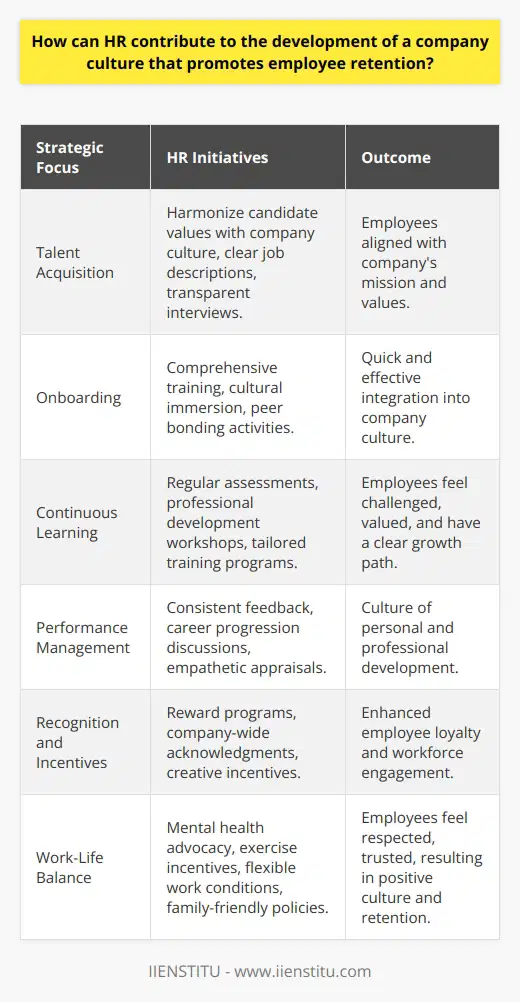
What are the key aspects of HR theory in relation to creating a work environment that fosters low employee turnover?
Key Aspects of HR Theory
To foster a work environment that results in low employee turnover, various aspects of Human Resource (HR) theory must be explored and implemented. These aspects can be clustered under effective recruitment, employee engagement, and compensation and benefits.
Effective Recruitment
Creating a workplace with low employee turnover begins with effective recruitment policies. It is crucial for HR managers to align job requirements with candidates' skills, experiences, and expectations. Properly assessing the candidate's fit with the company's culture, values, and long-term goals allows for better integration and commitment from the new hires. In addition, HR managers must clearly communicate job expectations and future career paths within the company to the candidates to prevent misunderstandings and resultant turnover.
Employee Engagement
Once employees are on-board, HR theories on employee engagement are central to maintaining low turnover rates. Open and effective communication between employees and managers enables employees to feel heard, valued, and appreciated, which fosters employee loyalty. Additionally, offering professional development opportunities demonstrates the organization's commitment to employees' career growth and development. Moreover, creating a positive work culture that fosters teamwork, collaboration, and work-life balance can contribute to persistent employee commitment and job satisfaction.
Compensation and Benefits
Lastly, competitive compensation and benefits packages play a significant role in retaining employees. HR managers should regularly review market trends, benchmark salaries, and adjust compensation packages accordingly. A comprehensive benefits program, including health coverage, retirement plans, and other perks, can increase job satisfaction and foster long-term employee commitment.
In conclusion, effective recruitment, employee engagement, and competitive compensation and benefits serve as key aspects of HR theory that contribute to creating a work environment where employees are less likely to leave. Implementing these practices can lead to lower employee turnover rates, increased job satisfaction, and a stronger, more productive workforce.
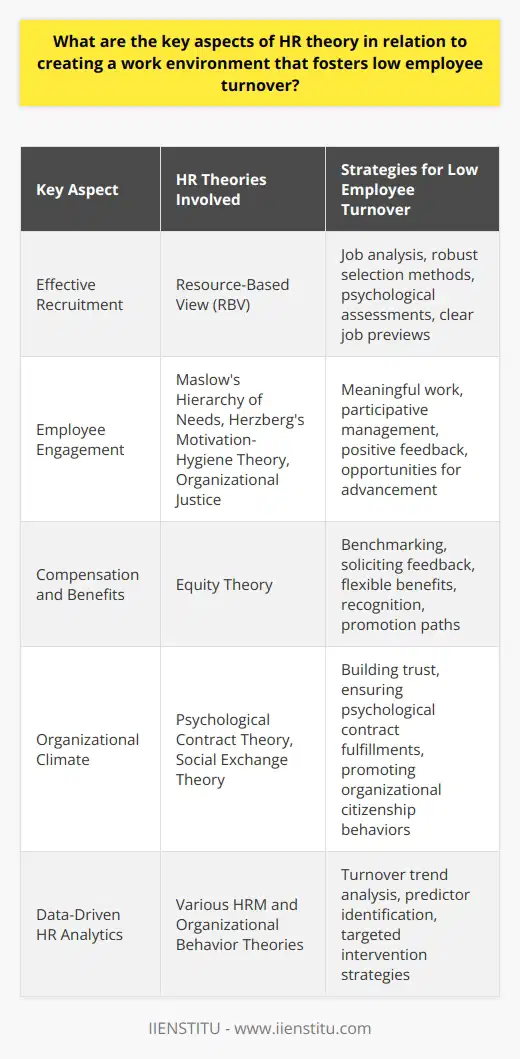
How can HR professionals effectively implement and monitor employee retention programs within an organization?
Establishing Employee Retention Programs
To effectively implement and monitor employee retention programs, HR professionals must first identify the key factors contributing to employee turnover within the organization. They can achieve this through conducting exit interviews and employee surveys, in addition to examining industry trends and benchmarking data.
Setting Clear Objectives and Strategies
Once the underlying issues are identified, HR professionals should establish clear objectives and strategies for the retention program. These objectives should address key concerns, such as promoting career advancement opportunities, maintaining competitive salaries and benefits, and fostering a healthy work-life balance. The strategies should focus on measurable goals and tangible outcomes to ensure the success of the program.
Tailoring Programs to Employee Needs
Retaining a diverse workforce requires tailoring retention programs to address the unique needs of different employee groups. Prioritizing flexible work arrangements, establishing mentorship programs, and conducting regular performance reviews are examples of effective strategies for different employee demographics. HR professionals should regularly evaluate these programs, gathering employee feedback and metrics to identify areas of improvement.
Creating a Positive Work Culture
A positive work culture plays a crucial role in employee retention. HR professionals should focus on fostering a culture that values collaboration, learning, and development, as well as recognizing and rewarding employee achievements. To achieve this, they can facilitate team-building events, provide professional development opportunities, and establish employee recognition programs.
Monitoring and Evaluating Program Efficacy
Ongoing assessment of employee retention programs is essential to ensure their efficacy. HR professionals should consistently monitor and evaluate the success of these programs, using data-driven approaches to track key performance indicators (KPIs). Employee turnover rates, retention rates, and employee satisfaction surveys should be regularly analyzed to identify the impact of implemented strategies and inform future decisions regarding the program.
Conclusion
In conclusion, HR professionals can effectively implement and monitor employee retention programs within an organization by identifying key factors contributing to turnover, establishing clear objectives and strategies, tailoring programs to employee needs, fostering a positive work culture, and consistently monitoring and evaluating the program's efficacy. Utilizing a data-driven and adaptive approach to retention will help organizations create an environment that promotes employee satisfaction and supports long-term success.
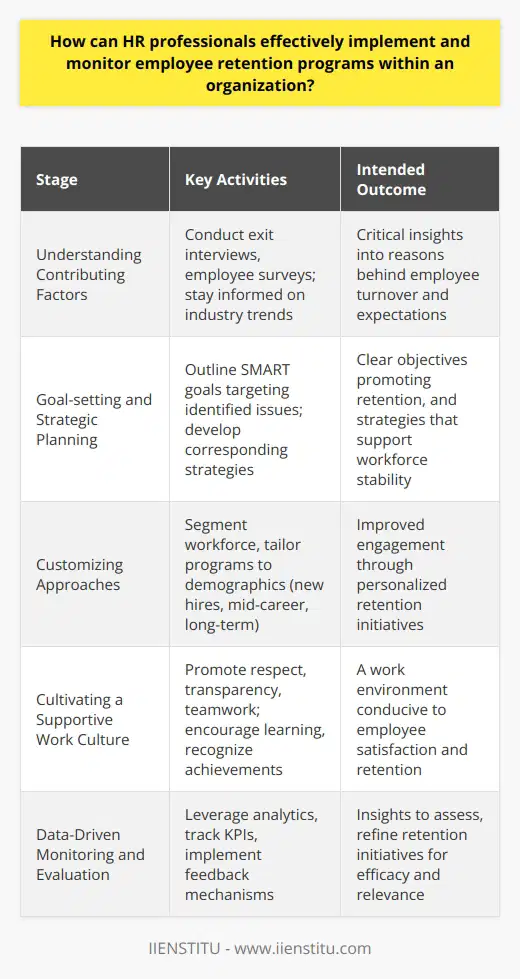
What is the role of HR in developing targeted interventions to address employee retention issues?
Role of HR in Employee Retention Interventions
Identifying Retention Issues
The first step in addressing employee retention issues is identifying the problem areas, and Human Resources (HR) plays a critical role in this process. HR professionals conduct exit interviews, analyze turnover statistics, and gather feedback from employees in order to determine the primary causes of attrition.
Developing Appropriate Interventions
Having identified the retention issues, HR plays an essential role in developing targeted interventions to address these concerns effectively. They design and implement measures, such as competitive compensation packages, performance incentives, and transparent promotion policies, to incentivize employees to remain with the organization.
Training and Professional Development
Beyond compensation and incentives, HR also focuses on providing employees with opportunities for personal and professional growth. This can include training programs, mentorship initiatives, and regular feedback to help them reach their full potential within the organization, fostering loyalty and long-term retention.
Employee Engagement Initiatives
To maintain a strong workforce, HR departments must also develop and implement employee engagement strategies. These activities can range from executing effective internal communication strategies to fostering a positive work environment, and organizing team-building activities that enhance workplace relationships and collaboration.
Recognition and Reward Programs
HR plays a crucial role in designing and managing recognition and reward programs that acknowledge and appreciate employee contributions. By implementing such programs, the organization can boost morale, improve job satisfaction, and foster a sense of accomplishment, ultimately contributing to employee retention.
Work-Life Balance Policies
Understanding the importance of work-life balance, HR also takes responsibility for developing initiatives that ensure employees have sufficient time and flexibility to manage their personal and professional commitments. Examples include policies, such as flexible working hours, remote work options, and generous parental leave, all of which contribute to an inclusive and supportive work environment.
Monitoring and Evaluation
Finally, HR is responsible for evaluating the effectiveness of the implemented interventions, gathering feedback from employees and identifying areas for improvement. Regularly monitoring these interventions ensures that employee retention remains a top priority and enables the organization to adapt to evolving workforce needs.
In conclusion, the role of HR in developing targeted interventions to address employee retention issues is multifaceted, encompassing identification, creating and implementing effective strategies, and ongoing evaluation. By focusing on these aspects, HR professionals can significantly contribute to a company's long-term success and sustainability.
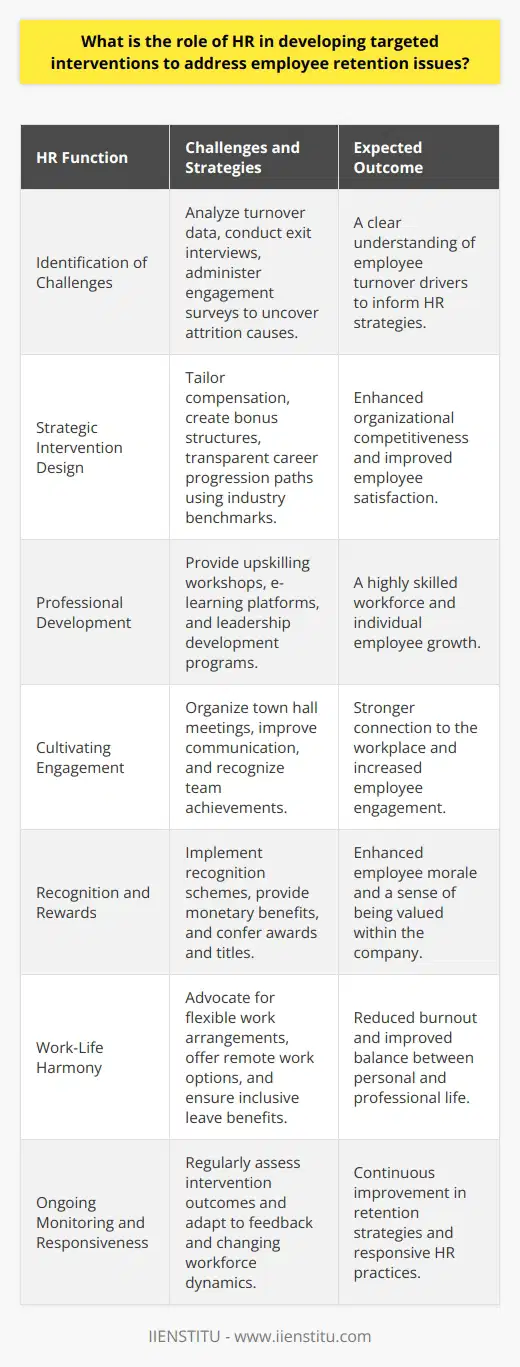
How can HR professionals leverage their expertise in organizational behavior and psychology to design effective retention strategies?
Understanding Employee Needs
HR professionals can leverage their knowledge of organizational behavior and psychology to understand employees' underlying motivations and tailor retention strategies accordingly. By identifying the specific factors that drive employee satisfaction and engagement, HR professionals can create work environments that meet these needs and foster commitment to the organization.
Holistic Retention Approaches
Utilizing a holistic approach to retention can also be a significant advantage for HR specialists. The integration of various elements, such as work-life balance, professional development opportunities, and a supportive organizational culture, can promote job satisfaction and reduce turnover. By considering the broader context of employees' lives, HR professionals can design retention strategies that address various aspects of employee well-being.
Leveraging Employee Feedback
Actively soliciting employee feedback can also provide valuable insights for HR professionals seeking to optimize current retention strategies. Regular surveys and informal discussions can allow HR professionals to gauge employee sentiment, identify key issues contributing to turnover, and develop targeted solutions. Encouraging open communication and emphasizing transparency can further contribute to long-term employee commitment.
Fostering Psychological Safety
Promoting a strong culture of psychological safety plays a crucial role in retaining employees. HR professionals must prioritize creating an environment where individuals feel comfortable expressing their ideas, concerns, and challenges without fear of repercussion. This kind of environment supports agile decision-making and innovation, which can trigger increased job satisfaction and commitment to the organization.
Customizing Retention Strategies
Finally, HR professionals should adopt tailored retention strategies based on employee segments, recognizing that different demographic groups may possess distinct preferences and priorities. By understanding the diverse factors that impact job satisfaction, HR can adopt a targeted approach to address specific employee groups, ensuring that interventions resonate and achieve the desired outcomes.
In sum, HR professionals can utilize their expertise in organizational behavior and psychology to design effective retention strategies by understanding employee needs, adopting holistic approaches, leveraging feedback, fostering psychological safety, and customizing strategies. By applying these principles, HR can create a work environment that is conducive to employee satisfaction and commitment, ultimately reducing turnover and benefiting the entire organization.
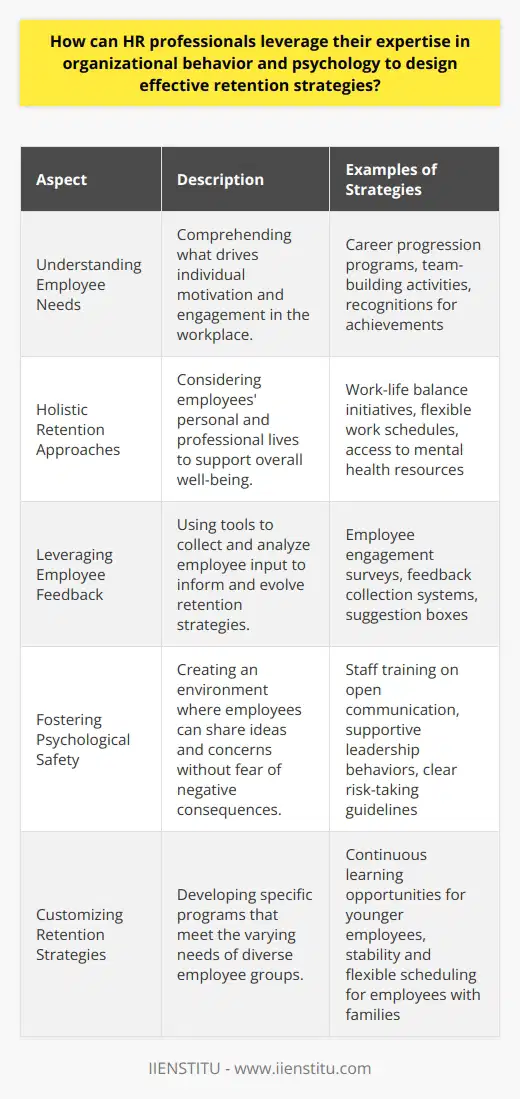
In which ways can HR analytics and data-driven insights help in refining and improving employee retention initiatives?
Identifying the Causes of Turnover
HR analytics can play a crucial role in identifying the root causes of employee turnover. By analyzing historical data on employee attrition and conducting exit interviews, organizations can pinpoint the factors that lead to employee dissatisfaction and departure. This information can help create targeted interventions to address these issues and improve employee retention.
Supporting Career Development
Data-driven insights can help organizations understand the career paths and skill development needs of their employees. HR analytics can highlight areas where employees are seeking growth opportunities, enabling organizations to tailor their training and development programs. By supporting employees' career development, organizations can foster employee satisfaction and loyalty, thereby reducing turnover rates.
Enhancing Employee Engagement
Employee engagement is a vital component of employee retention. HR analytics can help measure employee engagement levels and identify areas for improvement. For example, data on employee participation in training programs, feedback on internal communications, and performance metrics can help HR teams focus on initiatives that foster greater employee involvement and satisfaction. Higher engagement levels contribute to increased employee retention.
Tailoring Compensation and Benefits
Competitive compensation and benefits packages are essential to attracting and retaining talent. HR analytics can provide insights into industry benchmarks and employee preferences, allowing organizations to design tailored compensation plans that appeal to their employees. By offering attractive and competitive packages, organizations can ensure their employees feel valued and rewarded for their contribution, thus improving retention rates.
Promoting a Positive Workplace Culture
Data-driven insights can also help organizations promote a positive workplace culture. By analyzing trends in employee satisfaction, relationships among team members, and feedback on company policies and practices, HR teams can identify areas that need improvement. Implementing initiatives to create a supportive and inclusive work environment can lead to higher job satisfaction, resulting in increased employee retention.
In conclusion, HR analytics and data-driven insights have a significant potential to refine and improve employee retention initiatives. By focusing on identifying turnover causes, supporting career development, enhancing employee engagement, tailoring compensation and benefits, and promoting a positive workplace culture, organizations can decrease employee attrition rates and foster long-term employee satisfaction and commitment.

What is HR theory for employee retention and how can it be customized to fit different industries?
Understanding HR Theory for Employee Retention
HR theory for employee retention is a set of strategies, tools, and practices in human resource management aimed at increasing employee satisfaction, well-being, and engagement in order to reduce staff turnover and enhance organizational performance. A key aspect in customizing these strategies to fit different industries lies in understanding the unique challenges, characteristics, and opportunities present in each sector.
customization for Manufacturing Industry
In the manufacturing industry, customizing retention strategies may involve offering tailored training programs, competitive compensation packages, and clear career advancement opportunities. Implementing initiatives that promote employee safety and provide modern and comfortable working environments can also play a significant role in retaining skilled labor in this sector.
Adapting to the Service Sector
For the service sector, HR theory for employee retention may focus more on fostering a positive company culture and ensuring that employees feel valued and heard. Providing regular feedback, implementing flexible work arrangements, and encouraging a healthy work-life balance can contribute to the satisfaction and happiness of employees in the service industry.
Differences in the Tech Industry
In the rapidly evolving technology industry, one vital customization for effective employee retention is offering continuous learning and development opportunities. Additionally, providing highly skilled and capable employees with more autonomy and a sense of purpose in their work can foster a higher level of engagement, ultimately leading to longer-lasting employment.
Addressing Challenges in Healthcare
In healthcare, an industry with a high level of stress and burnout, it is essential to tailor employee retention strategies to support the well-being of employees. Organizational initiatives to reduce workplace stress, establish supportive networks, and acknowledge the accomplishments of employees, can improve employee retention in healthcare settings.
Organizational Size Matters Too
Besides industry-specific considerations, employee retention practices should also be adapted to the specific needs and characteristics of organizations, depending on their size and structure. For instance, smaller businesses may prioritize creating close-knit communities and fostering open communication among staff members, while larger corporations might emphasize opportunities for internal mobility and employee empowerment.
In conclusion, customizing HR theory for employee retention should respond to the particular challenges and opportunities faced by different industries, as well as take into account the unique characteristics of individual organizations. Such customization ensures that retention strategies are effective, efficient and relevant to the targeted workforce.
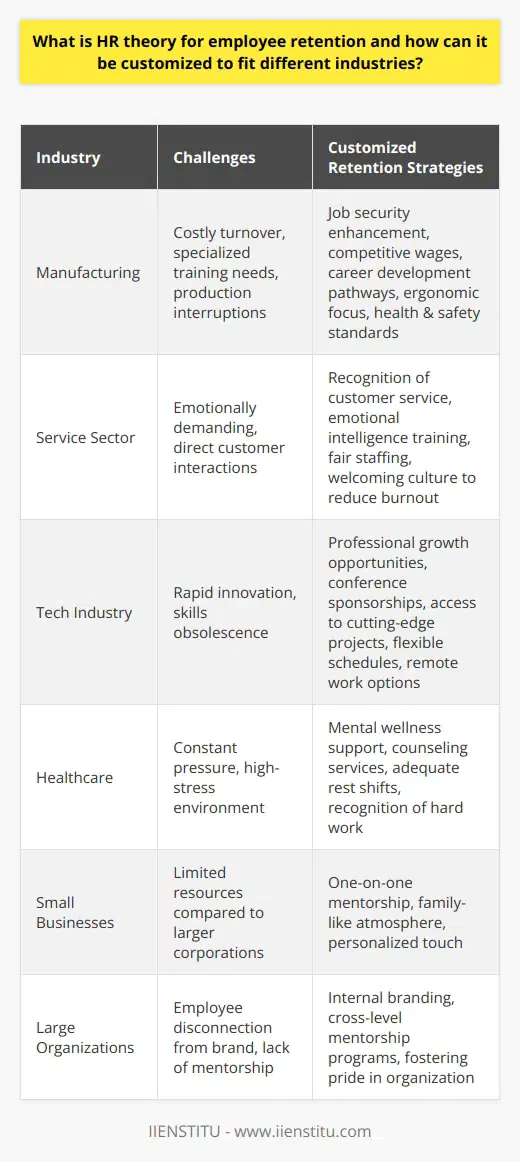
How do HR management techniques and interventions differ in their effectiveness in reducing employee turnover across various sectors?
Sector-Specific HR Management Techniques
It is essential to understand that HR management techniques and interventions must be tailored to the unique characteristics and needs of a given sector to be effective in reducing employee turnover. The differences in the effectiveness of these techniques across sectors can be attributed to varying work environments, expectations, and challenges faced by employees.
Manufacturing Industries
In the manufacturing sector, the focus of HR management initiatives often lies in improving workplace safety, maintaining machinery, and offering competitive compensation in order to retain qualified and skilled employees. Implementing effective training programs is also crucial in this sector, as employees working with heavy machinery require comprehensive knowledge and understanding of safety procedures to minimize the risk of accidents.
Service Industries
In service industries, such as hospitality and retail, HR management initiatives typically emphasize enhancing the work environment and prioritizing employee well-being. This includes offering flexible work schedules, access to wellness programs, and opportunities for employee engagement to create a more supportive and inclusive workplace culture. Additionally, companies in these sectors may focus on improving recruitment and selection procedures to hire candidates with the right skills and attitudes that align with organizational values.
Knowledge-Based Industries
For knowledge-based industries, like technology and finance, HR management techniques tend to prioritize employee development, performance management, and opportunities for career advancement. Companies in these sectors often invest in comprehensive onboarding programs, continuous professional development, and mentorship to ensure that employees are well-equipped with the necessary skills and knowledge to perform their roles successfully. Additionally, offering competitive compensation and benefits packages is essential in attracting and retaining top talent in these highly competitive industries.
In conclusion, the effectiveness of HR management techniques and interventions in reducing employee turnover across various sectors depends on their alignment with the unique context and needs of each industry. By understanding the specific challenges and expectations of employees in each sector, HR professionals can develop tailored strategies to address workforce concerns and foster a positive, supportive work environment that encourages employee retention.

In what ways can HR professionals ensure continuous improvement and adaptation of retention strategies to account for changes in the workforce demographics and expectations?
Understanding Workforce Demographics
To ensure continuous improvement and adaptation of retention strategies, HR professionals must first understand the changing demographics of the workforce. This involves analyzing factors such as age, gender, ethnicity, and educational background, as well as identifying emerging trends and potential skill gaps. By staying informed on the evolving workforce composition, HR professionals can implement targeted retention initiatives catering to the unique needs and expectations of different employee groups.
Fostering Employee Engagement
Employee engagement plays a critical role in retention, as engaged employees are more likely to remain in their organizations. HR professionals can boost engagement through frequent communication, transparency, and offering meaningful opportunities for growth and development. By creating a work environment where employees feel valued, connected, and empowered, HR professionals can make a lasting impact on employee satisfaction and retention.
Leveraging Technology and Data Analytics
In today's data-driven world, HR professionals must embrace technology and data analytics to drive their retention strategies. By analyzing key metrics such as employee turnover rates, satisfaction levels, and feedback obtained through exit interviews or employee surveys, HR professionals can identify underlying issues and tailor their strategies to address them effectively. Moreover, using predictive analytics can help identify potential retention risks and enable HR professionals to take preemptive measures.
Prioritizing Employee Well-being
Prioritizing employee well-being is essential to retaining top talents, as it directly impacts job satisfaction and employee performance. HR professionals can support employee well-being through programs that emphasize physical and mental health, work-life balance, and stress management. By fostering a culture that prioritizes employee welfare, HR professionals can build strong, well-adjusted teams that are more likely to stay with the organization.
Continuous Review and Feedback
Lastly, HR professionals should consistently evaluate the effectiveness of their retention strategies and adapt to the shifting workforce landscape. This involves seeking regular feedback from employees and managers, as well as conducting periodic reviews to assess the success of implemented initiatives. By incorporating a continuous improvement approach, HR professionals can iteratively refine their retention strategies and ensure they remain relevant in the face of ever-changing workforce demographics and expectations.

What is the role of HR in implementing employee engagement initiatives to increase retention?
Role of HR in Employee Engagement
Understanding Employee Needs
The core role of Human Resources (HR) in implementing employee engagement initiatives is to recognize and understand the needs of employees. By conducting periodic surveys and informational interviews, HR gets a better understanding of employee expectations and their diverse experiences in the workplace. This information is crucial for designing and implementing customized engagement programs.
Developing Effective Strategies
HR plays a vital role in developing effective engagement strategies that cater to employees' diverse needs. In consultation with senior management, HR develops comprehensive plans including skill enhancement programs, team-building activities, and opportunities for career progression. Additionally, HR ensures that these initiatives align with the organization's broader goals to ensure maximum productivity and efficiency.
Facilitating Communication Channels
Transparent and effective communication channels are imperative for successful employee engagement. HR facilitates accessible communication platforms, encouraging employees to voice their concerns, ideas, and suggestions. Through open forums and feedback mechanisms, HR builds trust and fosters a sense of belonging among employees, resulting in increased retention.
Recognition and Reward Programs
Acknowledging employee achievements and rewarding exceptional performance are significant factors for promoting engagement. HR designs and implements tailored recognition and reward programs to motivate employees, encourage healthy competition, and promote productivity. These programs not only recognize employees’ outstanding work but also demonstrate the organization's commitment to their professional growth.
Promoting Work-Life Balance
A supportive work environment that encourages a healthy work-life balance contributes to employee satisfaction and, consequently, retention. HR formulates policies and extends support to help employees maintain personal and professional equilibrium. This approach may include offering flexible work schedules, providing mental health resources, and fostering a culture of mutual respect and understanding.
Overall, HR plays a critical role in implementing employee engagement initiatives to increase retention in an organization. By proactively identifying employee needs, devising effective strategies, facilitating communication channels, designing recognition programs, and promoting work-life balance, HR significantly impacts long-term employee satisfaction and organizational success.
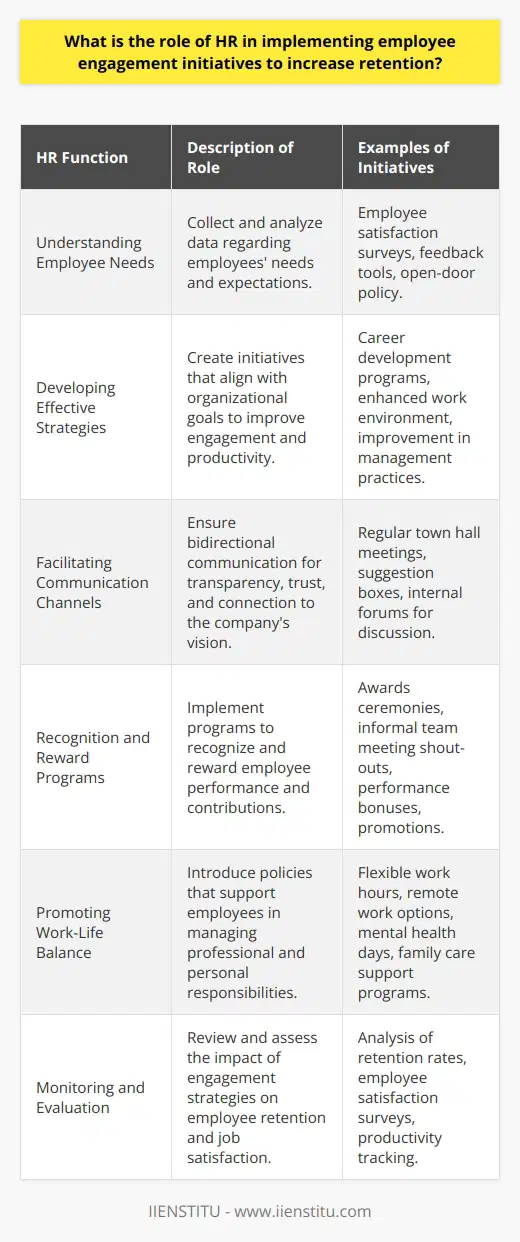
How can HR professionals create and sustain a learning and development environment that fosters employee retention?
Promoting Continuous Learning
To create and sustain a learning and development environment that fosters employee retention, HR professionals should focus on promoting continuous learning among employees. This can be achieved by providing access to relevant training programs, workshops, and e-learning platforms that cover skill sets vital to their roles. Additionally, they should encourage employees to attend conferences and industry events, thereby exposing them to new ideas and practices.
Mentorship and Coaching Programs
Establishing structured mentorship and coaching programs within the organization can also contribute to employee retention. Mentorship allows experienced employees to share their knowledge and expertise with junior colleagues, while coaching helps employees develop specific skills and improve their performance. Both methods contribute to employees' personal and professional growth, leading to higher job satisfaction and increased likelihood of retention.
Opportunities for Career Advancement
Ensuring opportunities for career advancement within the company is another key driver of employee retention. HR professionals should work closely with management to implement transparent performance evaluations and promotion criteria, allowing employees to understand the requirements and expectations for career growth. This clarity encourages employees to continuously pursue development opportunities, raising their commitment to the organization.
Fostering Collaborative Learning
Fostering a culture of collaborative learning can also contribute to boosting employee retention rates. HR professionals should facilitate collaboration by incorporating team-based projects and cross-functional work groups into the learning and development strategy. This approach allows employees to learn from their peers and gain exposure to different perspectives, thereby encouraging a culture of continuous learning and improvement.
Recognizing and Rewarding Learning Achievements
Finally, it is essential that learning achievements are recognized and rewarded within the organization. HR professionals should collaborate with management to establish a system of incentives and rewards that is aligned with the company's culture and goals. Acknowledging employees' learning efforts and accomplishments can boost their motivation, engagement, and commitment to remain a part of the organization.
In conclusion, by promoting continuous learning, implementing mentorship and coaching programs, ensuring opportunities for career advancement, fostering collaborative learning, and recognizing and rewarding learning achievements, HR professionals can create and sustain a learning and development environment that effectively fosters employee retention. This approach not only benefits individual employees but also contributes to the long-term success and growth of the organization.
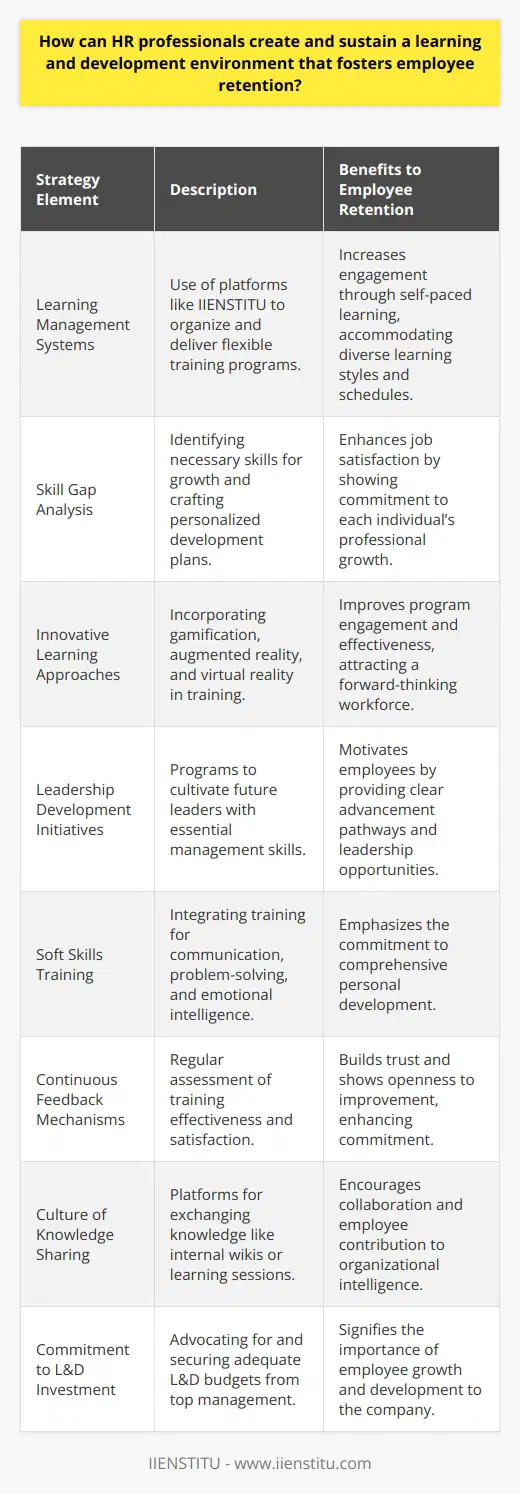
What are the ethical considerations that HR must address when designing and implementing employee retention strategies?
Ethical Considerations in Strategy Design
The ethical considerations that HR must address when designing and implementing employee retention strategies encompass several key areas, including transparency, fairness, and respect for individual rights. These factors play a central role in promoting an ethical organizational culture.
Transparency and Communication
Firstly, HR must ensure that the retention strategies are openly communicated to all employees. This transparency fosters trust as it allows employees to understand their value within the organization and the steps being taken to keep them engaged and committed. Moreover, an open communication process can encourage employee feedback, which is vital when evaluating and refining retention initiatives.
Fairness and Equity
Secondly, fairness in employee retention strategies is essential. HR must make certain that opportunities for growth, development, and recognition are equally accessible to all employees, regardless of their background or role. Furthermore, HR professionals need to avoid any discriminatory practices, such as favoritism or biased treatment. Equitable treatment ensures a fair working environment where no employee feels undervalued or overlooked.
Respect for Individual Rights
Lastly, respect for individual rights must be considered when implementing employee retention strategies. HR professionals should be mindful of diverse needs and preferences, as well as privacy concerns when gathering employee data for retention initiatives. By upholding employee rights, HR can craft strategies that respect the unique circumstances of each employee while also guiding them towards a shared vision of long-term commitment and engagement.
Balancing Organizational Needs
In addition to these ethical considerations, HR must also find a balance between the needs of the organization and the welfare of its employees. Designing retention strategies that effectively address both business objectives and employee satisfaction serves the greater good of promoting both organizational success and employee well-being.
In conclusion, ethical considerations in employee retention strategies are crucial to maintain a transparent, fair, and respectful organizational culture. By adhering to these principles, HR professionals can create an environment that not only retains employees but also fosters a commitment to the organization's values and objectives.
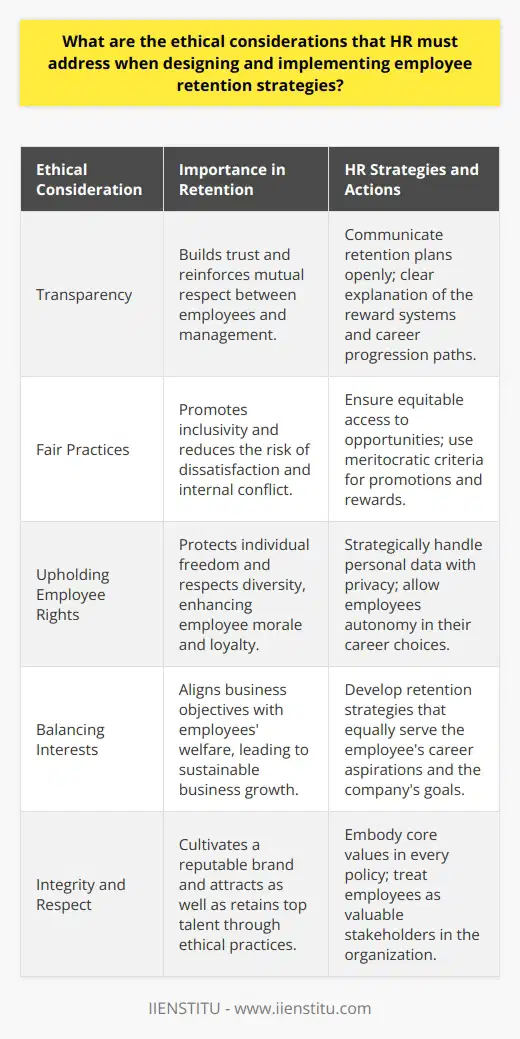
How does HR improve employee retention by addressing issues related to diversity and inclusion within the organization?
Promotion of Diversity and Inclusion
Human Resources (HR) plays an essential role in promoting diversity and inclusion in the workplace. By doing so, they help to increase employee retention rates. Diverse and inclusive work environments provide a sense of belonging and engagement among employees, crucial for employee retention.
Addressing Diversity Issues
HR can improve employee retention by addressing diversity issues. This can be in the form of anti-discrimination policies or training programs. When employees feel treated with respect and fairness, they are more likely to remain with the organization. Moreover, diverse beliefs, backgrounds, and perspectives can foster innovation and creativity, increasing workplace productivity.
Creating Inclusive Cultures
Another strategy pertains to the creation of inclusive cultures. In such environments, individual differences are not only accepted but also valued. HR can facilitate this by implementing policies that encourage the acceptance of diversity. When employees feel valued for their unique contributions, they are more likely to stay committed to their roles.
Collaborative Decision-making
The involvement of employees in decision-making processes is also essential. This means creating avenues for employees to voice their opinions and ideas. It boosts their morale and increases their sense of ownership, further promoting retention.
Improved Communication Channels
HR can also improve communication channels to reduce misunderstandings and conflicts, or even prevent them from happening altogether. It allows for the establishment of a common understanding, facilitating healthy working relationships. When employees are happy with their relationships at work, they are more likely to remain.
In conclusion, by proactively addressing diversity and inclusivity issues, HR departments have the power to greatly improve retention rates in organizations. By fostering environments that recognize, respect, and value individual differences, HR can not only retain employees but also attract top talent. This results in a win-win situation for all parties involved.
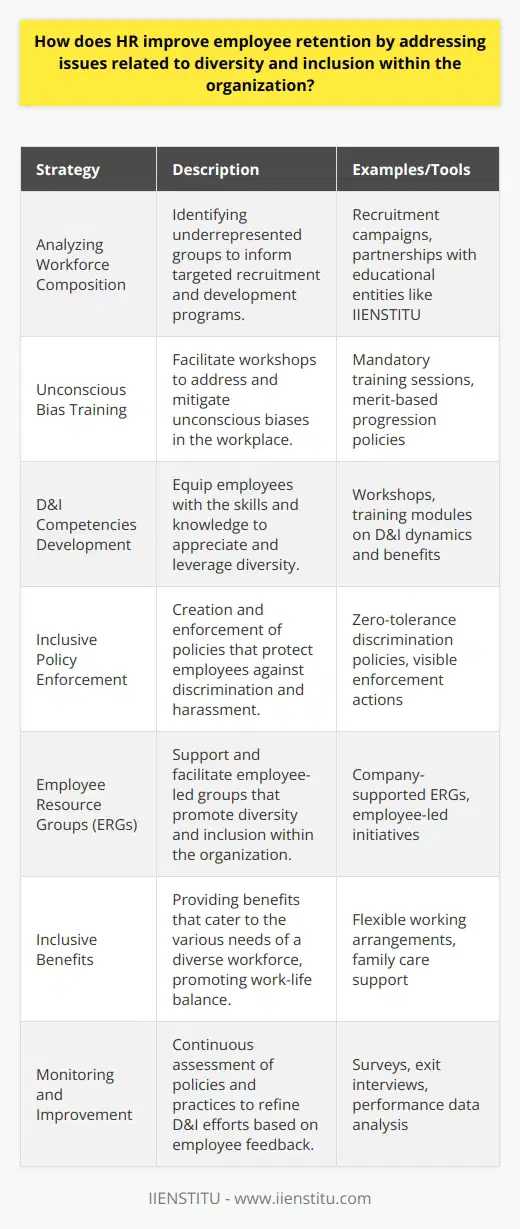
What role does HR play in facilitating effective communication and feedback channels to enhance employee retention?
HR's Role in Communication
Human Resource (HR) departments play a crucial part in maintaining effective communication and feedback channels in an organization. Their crucial function helps to boost employee retention.
Promoting Open Dialogue
HR professionals often act as a conduit between management and staff, ensuring a two-way communication process. They foster an open dialogue environment. This openness encourages employees to raise their concerns.
Handling Employee Feedback
Furthermore, HR managers handle employee feedback efficiently. They guarantee that employees' voices and concerns reach management. Employees also receive constructive feedback on their performance.
Mediating Conflict Resolution
When conflicts or disagreements occur, HR professionals step in. By utilizing effective communication strategies, they can mediate these situations. Conflict resolution is necessary to maintain a harmonious work environment.
Building Trust through Transparency
Transparency in communication is essential. HR cultivates trust among employees through transparent actions and messages. Trust reduces job dissatisfaction and the likelihood of resignations.
Supporting Career Growth
Another tool for increasing retention is career development support. HR communicates available opportunities and fosters an environment of growth. Employees, feeling valued and with potential for advancement, are less likely to exit.
Monitoring and Improving Satisfaction
Finally, HR runs employee satisfaction surveys and organizes feedback sessions. They analyze the data to understand how to improve satisfaction levels. Happy employees typically stay longer in organizations.
In conclusion, effective communication and feedback channels, facilitated by HR, are critical to employee retention. This process ensures a healthy, open, and supportive working environment that retains employees.
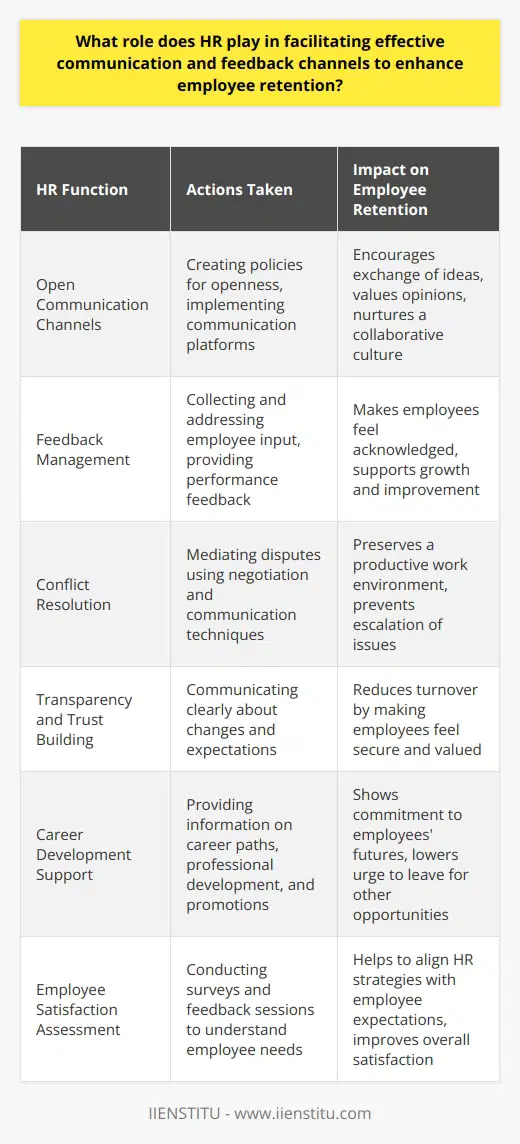
How can HR professionals collaborate with other organizational functions to align employee retention efforts with overall business strategy?
Collaboration between HR and Organizational Functions
HR professionals can collaborate with other organizational functions to align employee retention with the overall business strategy. Communication strikes as the first notable way. Regular dialogues between HR and strategic units can ensure apt talent retention priorities.
Formulating Shared Goals
Shared goals creation adds valuable weightage too. Identifying shared interests and uniting them aids in devising a strategy benefiting the entire organization.
Cross-Functional Training
Cross-functional training emerges as another approach. HR can join hands with department leaders to provide training that encourages employees to grasp different aspects of the business. This broadened understanding aids in mutual growth of employees and enterprise alike.
Participation in Strategic Planning
HR’s active involvement in strategic planning plays a crucial role as well. Their expertise on individuals and teams’ capacities can bring forth optimal implementation of business goals.
Links between Performance Management and Business Goals
Also, tying performance management with overall business objectives promotes employee retention. Allowing employees to visualize their contribution enhances individual performance and fosters a stronger tie to the organization.
Use of Technology
In today’s age, technology can render unaccountable aid. HR tech tools can facilitate coordinated input and data analysis from cross-functional stakeholders.
Summary: Aligning HR and Business Strategy
In essence, HR professionals' collaboration with other functions can aid in syncing employee retention efforts with the organization’s big picture. It ensures talent management aligns with business objectives, thereby driving a more successful enterprise.
